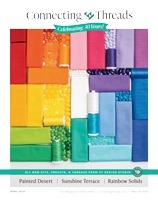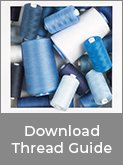Applique - Lay It All Out!
by Karen Johnson
Nearly all methods of applique require some tracing. If you have a light box, use it! It will make your life easier and you won't get all squinty from so much tracing. If you don't have one, don't buy one unless you plan to use it a lot. You can easily create your own makeshift light box! 1. Find a window. Tape the original drawing to any brightly lit window, tape your fabric over the top and trace. Sorry, you can't do this one at night. 2. A glass coffee table. Just place any light fixture, or small lamp under your glass coffee table and trace away! 3. My favorite method is to use my Sew Steady acrylic table. It's already in my sewing room and I just slide a light bulb fixture under it (I get the fixture at the craft store).
Numbering your templates. The Free pattern we provided is not a complicated design, so numbering is probably not necessary, but if you have a complicated design, like a baltimore album block, or any floral arrangement, it might be tricky to keep track of where everything goes. If the original pattern has the pieces pre-numbered, I highly recommend you number your templates as you trace them. Much easier to keep track of!
Keeping it in place. Once you've completed all your prep, you'll want your pieces to stay in place while you stitch. You have many options for this:
- Glue. If you are keeping freezer paper in your template, a little dot of glue stick or Roxanne's glue will keep it down and will launder out later. Don't use too much, and keep it away from your stitching edge. If you don't have freezer paper in the piece, you can still glue, just be careful to put it on the seam allowance, and away from the stitching edge if possible. You don't want the glue coming through to the right side of the fabric.
- Basting. This will take a little more prep time, but is worth it if you don't want glue or pins in your work. Simply hand baste your pieces in place and cut the threads when you're done.
- Pinning. Pinning is a fast easy option, but if your pins are too long, they'll get in your way when you stitch and drive you crazy! I recommend (and use all the time), appliqué pins. They are teeny tiny, both in length and in the size of the head. If you use these pins from the back, they'll mostly stay out of your way. Love them!
Layout. Finally, if you have a complicated pattern, how do you know exactly where to place your pieces when you stitch?
- More tracing. If your background fabric is a light color, consider tracing the entire design plan right on your background fabric. Use fine tipped water soluble markers, and draw on the INSIDE of the lines. This will allow you some wiggle room for moving things around later, and if your finished stitching isn't exact, you won't have to worry about covering those marks.
- Cheat Sheet. I've tried this a like it a lot. Using either Golden Threads tracing paper, or a lightweight non fusible, woven interfacing (that's fairly sheer), trace the final design on the paper/interfacing. This will be your guide. Pin or baste it to your block and leave it in place all the while you're stitching. When you're ready to lay down a new piece in your design, just lay the tracing over your block to see where the piece is supposed to go. I prefer the interfacing because it doesn't crinkle and make noise, and I can baste it to the block and move it out of my way while I'm stitching.
Now you're ready to stitch!











